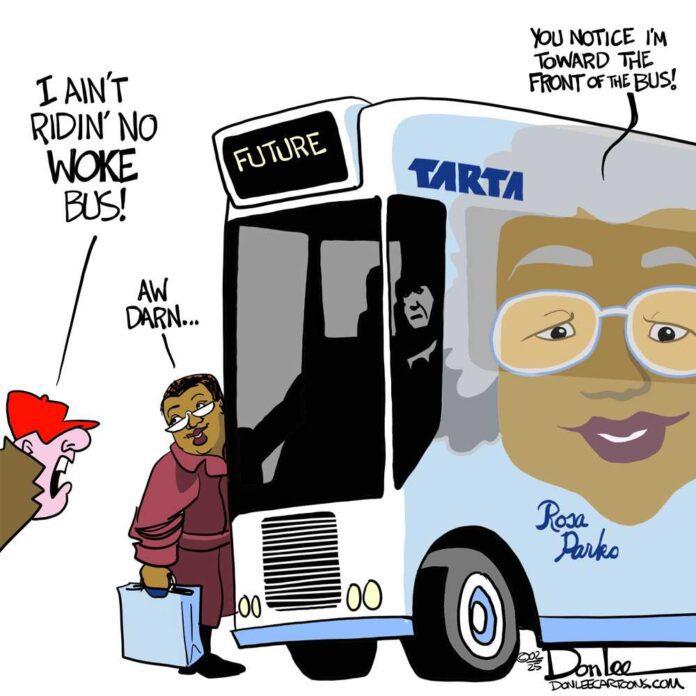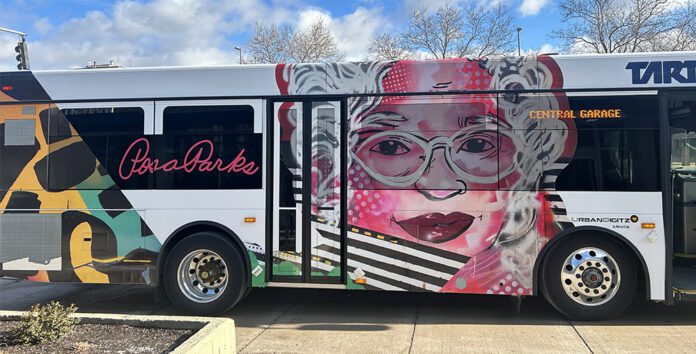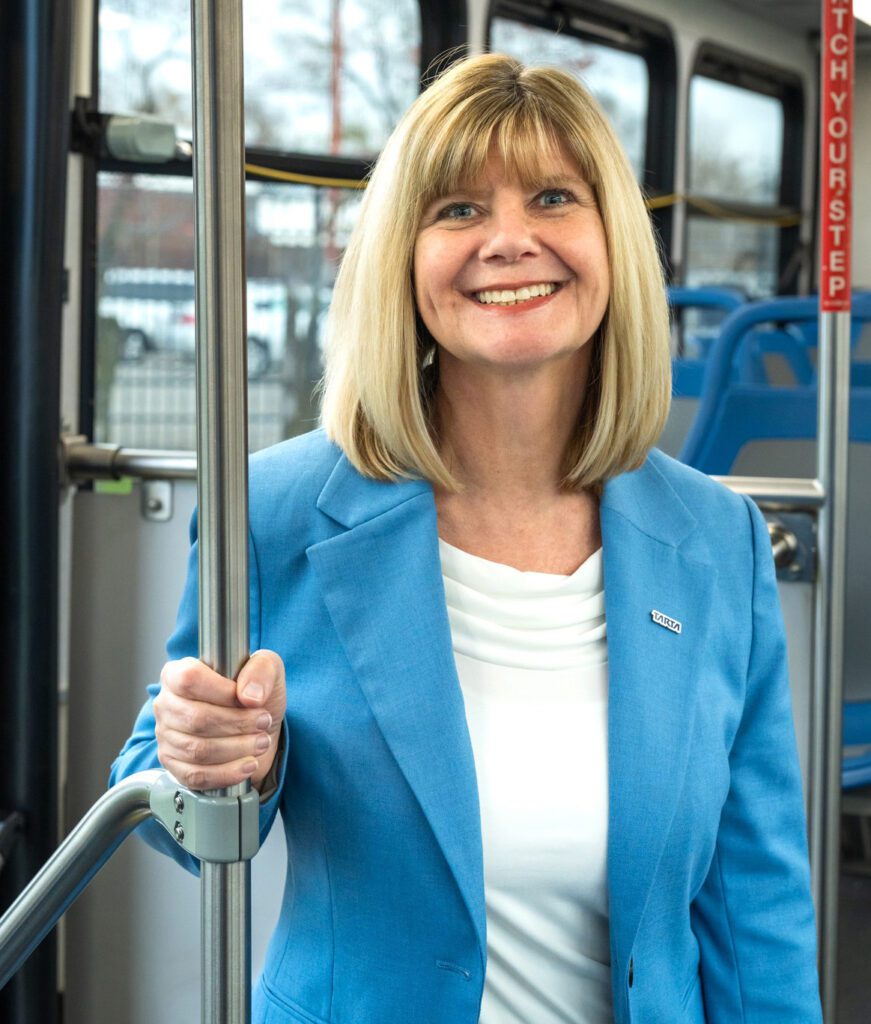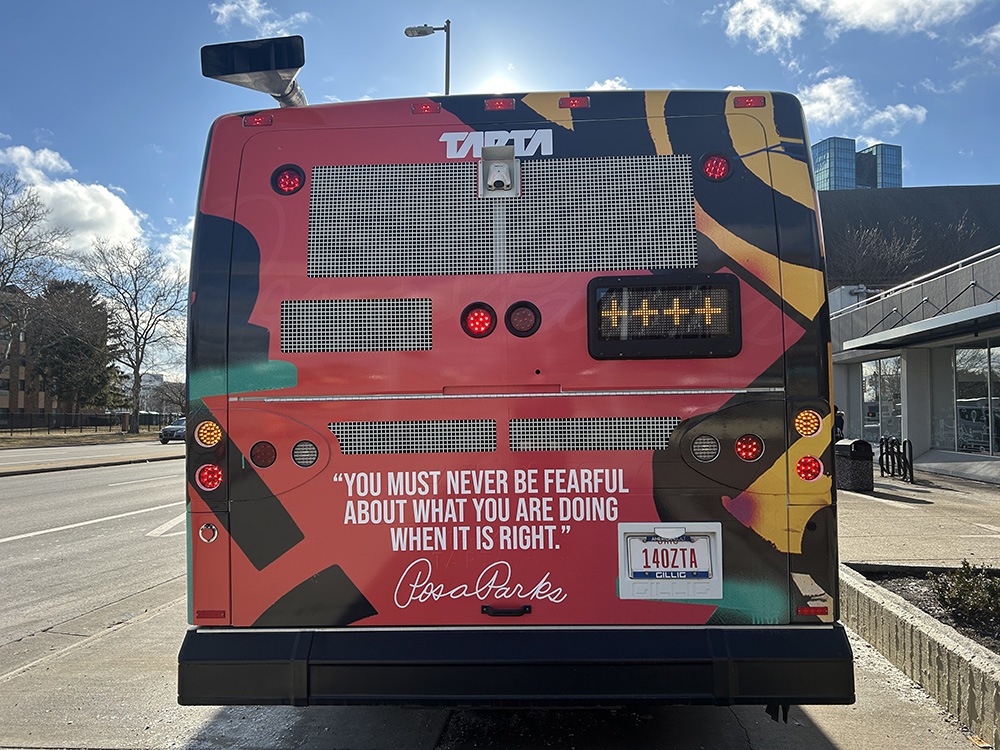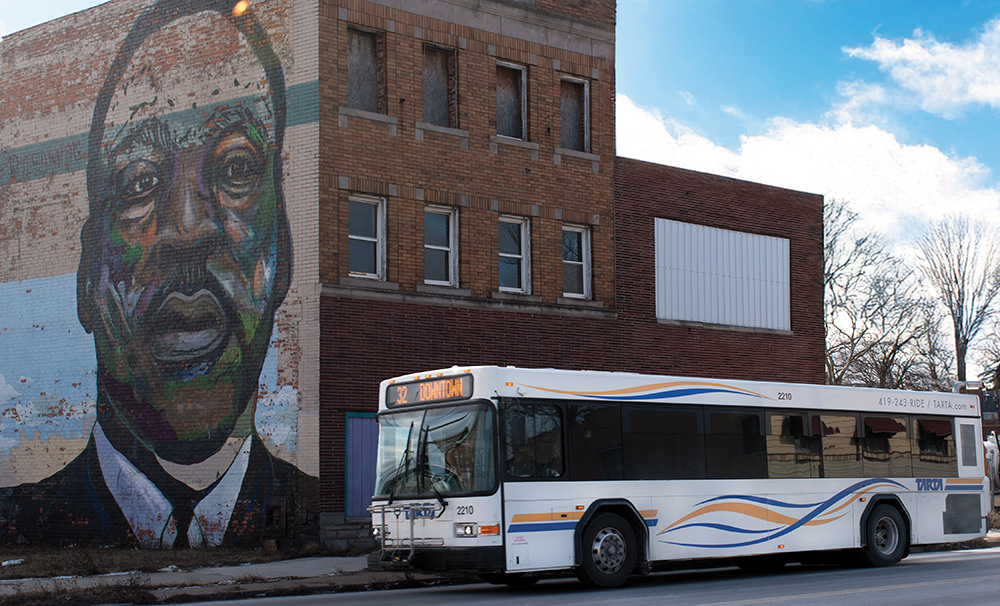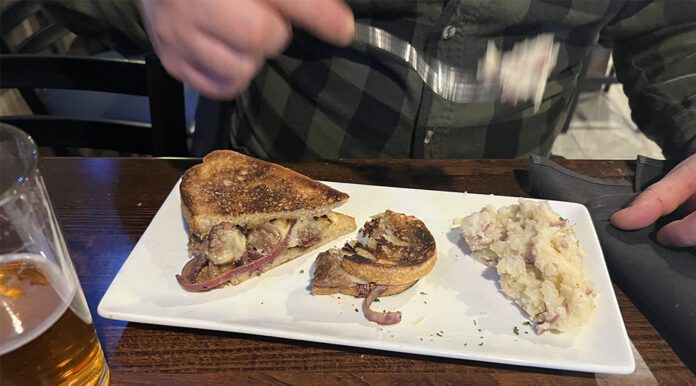Borderline Grill gets job done right

SYLVANIA – ‘Of course we would go on the busiest night since they opened.’ That was the first thought that jetted across my mind when my wife and I walked into Borderline Grill on a recent Saturday night.
It was approximately 7:20 p.m., and the restaurant was near standing-room only. Families out for the night; couples; four-tops; six-tops; all trying the new restaurant on the block.
Yes, it was busy, and there was a little wait for our order, but the food and drinks moved at a steady pace. Borderline has only been open since Jan. 17, and as a scar-tissued foot soldier of customer service, it wasn’t a stretch to say staff stayed busy between pick-ups. They were active during any downtime: clearing tables, wiping the windows, rolling silverware in fresh napkins.
“Tonight is the busiest night we’ve had,” said bar manager Chris Ryan as he handed over my Makers and ginger ale and a beautiful Prosecco for my wife, Victoria. “Service has been on-point. People are happy, and the food’s coming out fast. This is exactly what we’ve wanted.”
I could hear the bustle from the kitchen as the line tackled their orders. The sizzling oil, plates slapping the counters, the chatter down the line … it all funneled out organically every time someone walked through the double doors. There wasn’t the frantic shuffling, flare ups, confusion or spastic yelling that one might be used to from watching Hell’s Kitchen or The Bear.
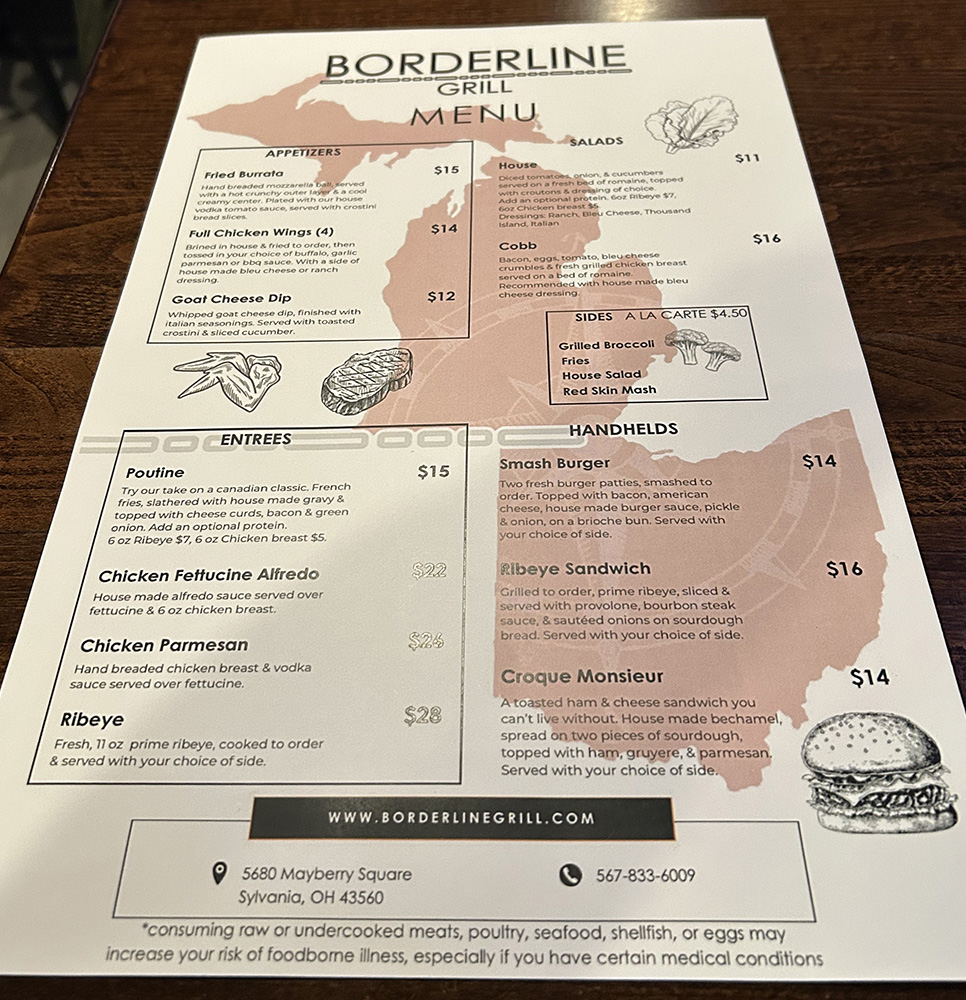
On the contrary, under the direction of head chef Kris Parker, the kitchen line ran smoothly for an operation that is building its identity. I was lucky to have a couple minutes with him during service.
“I haven’t come up for air in the last four hours,” he said, exasperated but gleeful. “We actually ran out of our feature item, the Smash Burger, because we prepped for how the last two Saturdays went. But they just kept coming in tonight. It’s been a great surprise.”
This is great news for him, his wife and marketing manager Nikki Falk, who is also the co-owner/operator of the business. Having served their time at Carrabas, Applebees, Longhorn and Barr’s Public House in Maumee, this is their opportunity to shine, given the obstacles.
“We wanted to open last year,” said Falk, via email. “But we had hold-ups. The contractors for the fire suppression, for example; they never sent their plans over [to the Department of Inspection]. This was around Thanksgiving. After we waited long enough, it took an affirmative email and they got their butts into gear.”
That little wait for our order I mentioned in the beginning took 23 minutes between the appetizers arriving to us and digging into the entrees. To save you the ramblings of a pompous Michelin critic, I’ll try to keep it within reason.
The first appetizer was the fried burrata – a cool mozzarella ball underneath hot, fried and crispy breading sitting atop scratch-made vodka sauce and topped with shaved parmesan.


“Next time, I’m getting two,” I said aloud, and my wife responded by nodding because she had a mouthful of food.
The goat cheese dip followed – whipped goat cheese with cucumber and crostini slices. It was a hit; delicate and blended well, with just enough seasoning to bring it home.
“I wanna bathe in this,” said my wife. I concurred, and still do. It really is that good.
For the entrees, we ordered the Croque Monsieur (French ham and cheese sandwich) and ribeye sandwich. There wasn’t much conversation or note-taking during this part of dinner.
When the food does the talking and you shut up and listen … that’s how you know you came to the right place. Between the ham, be’chamel (French creamy white sauce) and gruyere (cheese), and my face full of prime ribeye, caramelized onions and provolone (both on toasted buns), all we could do was stare at each other and have that silent conversation of nodding in unison. I would recommend the grilled broccoli for choice of side.
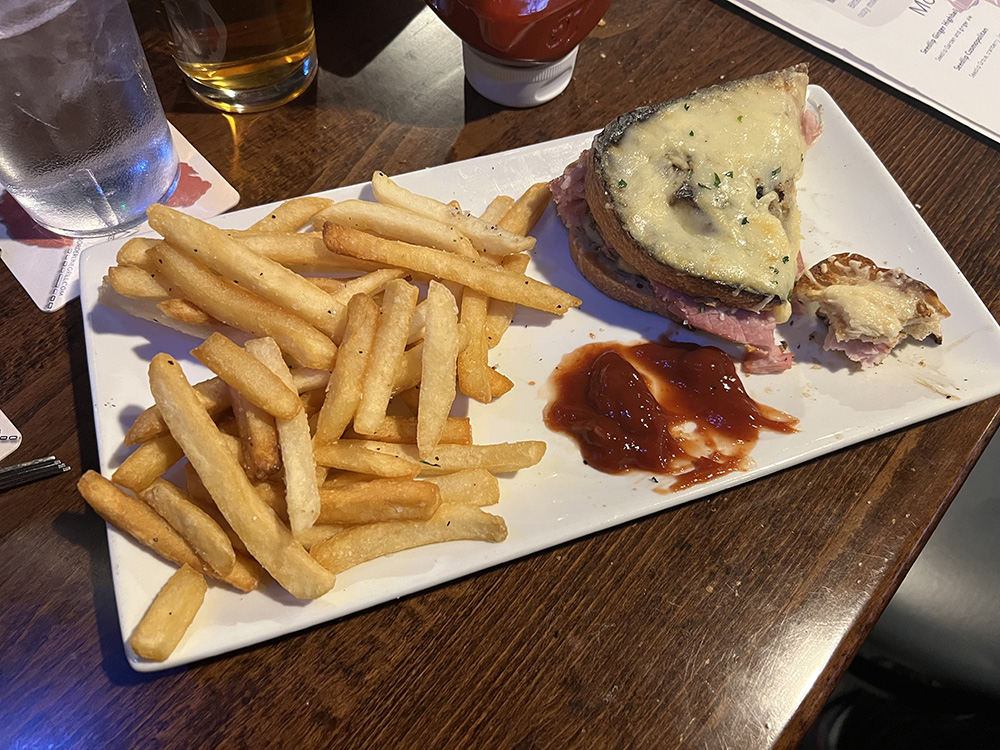
After looking at the ceiling and rubbing our bellies, we decided on the molten lava cake for dessert. Out of necessity, of course.
Chocolate cake … melting ice cream … hot fudge dressing … I probably sound like Homer Simpson by now.
Borderline Grill is in a prime position, being a stone’s throw from Centennial Terrace. And if they’re packed in the dead of winter, then spring and summer will only deliver upwards return.
This is scratch cooking as good as you can get it. The question is if you want the job done or the job done right.
Borderline Grill $ is located at 5680 Mayberry Square E in Sylvania.
Heat pumps cut carbon emissions, saves money, helps climate

One of the weapons that can be used to fight the ongoing challenge of climate change is the electric heat pump. Electric heat pumps move heat from one location to another, instead of producing it.
In colder months, they pull heat from outdoor air and bring it inside. In hot weather, they send the heat outside. Since heat pumps move heat rather than make it, they use less energy than traditional heating systems and don’t make the pollution that comes from burning fossil fuels.

Heat Pumps are popular. More units were sold than gas furnaces in 2024, carrying on a trend that started in 2022. In 2023, Americans bought 21 percent more heat pumps than gas furnaces (see figure). Keep in mind that some homes have more than one heat pump.
In September 2023, the U.S. Climate Alliance, a coalition of 25 states, publicized plans to install 20 million heat pumps by 2030. To hit this goal, present install rates need to increase 300 percent. Ohio is not a member of this alliance.

There are several good reasons for the growing popularity of heat pumps.
One strength is their stingy use of electricity. Modern heat pumps can function at 300 to 400 percent efficiency or more. In other words, they produce three to four times more heat energy than the electricity they use. The best space heaters achieve only 95 percent efficiency. Using less electricity saves money.
Heat pumps offer financial savings. A National Renewable Energy Lab (NREL) study found that out of the 49 million households using electricity, fuel oil or propane for heating, and using air conditioning, 92 to 100 percent could lower their energy bills (see Fig. 2).
Yearly savings are usually between $300 and $650, depending on the heat pump’s efficiency. Homes that use natural gas for heating would experience smaller, if any, savings. 64 percent of Toledo homes are heated by gas, while 26 percent are heated with electric power.
Heating and cooling accounts for about 60 percent of household emissions. Heat pumps can cut heating-related fossil fuel use by 40 percent or more. Over 15 years, heat pumps, specifically in Ohio, will lower fossil fuel emissions into the atmosphere by as much as 36 percent compared to gas furnaces. This is important since household emissions contribute to climate change.
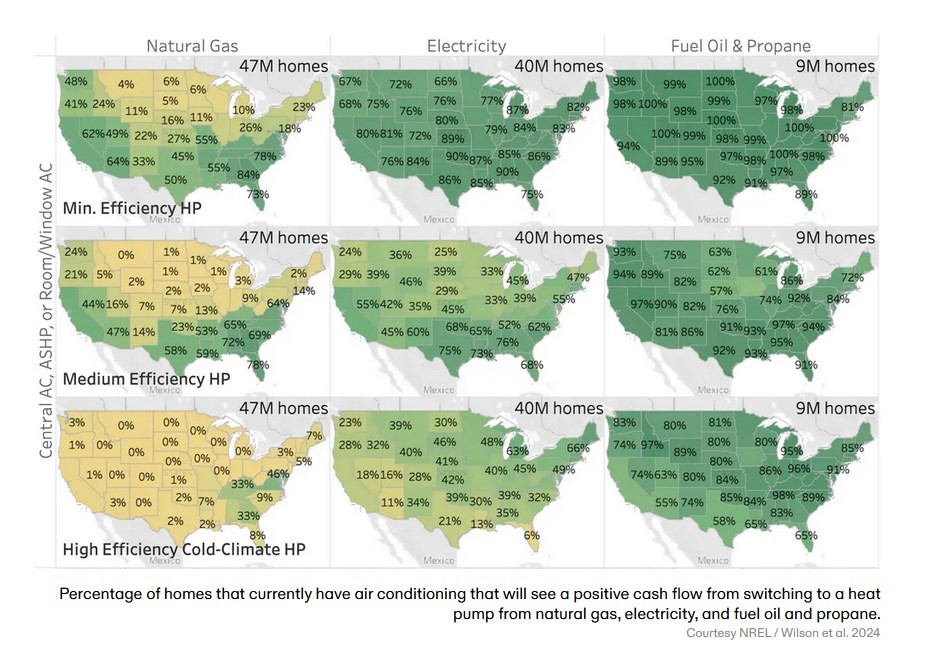
Heat pumps are healthier than gas-burning furnaces since gas heating systems are a major source of indoor air pollution, according to the EPA. When gas appliances malfunction, they can produce carbon monoxide (CO), which interferes with the blood’s ability to carry oxygen and can worsen heart conditions.
Natural gas used in homes often includes volatile organic chemicals (VOCs), such as benzene. VOCs can cause cancer and may form harmful pollutants, like particulate matter and ozone, when leaked. This particulate matter (PM) from gas heat can harm health. PM can irritate the eyes, nose, throat and lungs, increase the risk of heart attacks, and increase hospital visits for heart-related conditions.
To learn more about heat pumps, I talked to Brian Vanderhorst, the founder and owner of Shrek Heating & Air Conditioning, founded in 2017. Vanderhorst has been in the business for 20 years. He states that he has spent significant time “learning about all facets of the industry, one of those being the operation and installation of heat pump equipment.”
One of the characteristics of heat pumps is that they become less efficient in cold weather. But, according to Vanderhorst, “the capacity to deal with the cold has advanced considerably with inverter-driven compressors and temperature sensors inside the units. The technology advancements have allowed the use of heat pumps in much colder climates.”
Vanderhorst emphasized that proper installation is essential for optimal operation in cold temperatures.
“That’s where it becomes important that you, and whoever you’re hiring as a contractor, understands the limitations and understands the specifications from the manufacturer,” Vanderhorst said. “And understand the goal you’re trying to accomplish as a homeowner, whether that’s being green or reducing energy consumption or whatever.”
Vanderhorst added that “in very cold climates, there is a diminished capacity for the output of heat. And so, generally speaking, in very cold climates, there is an electric backup which is commonly called a heat strip installed in an air handler, or even using fossil fuel backup.”
When the indoor temperature gets close to the desired point, the system automatically reduces energy use. It adjusts to keep an ideal heat balance. This helps avoid temperature swings and keeps the indoor environment stable and comfortable.
Choosing the right model is important for reliable operation in freezing conditions. There are models designed to work well in colder climates.
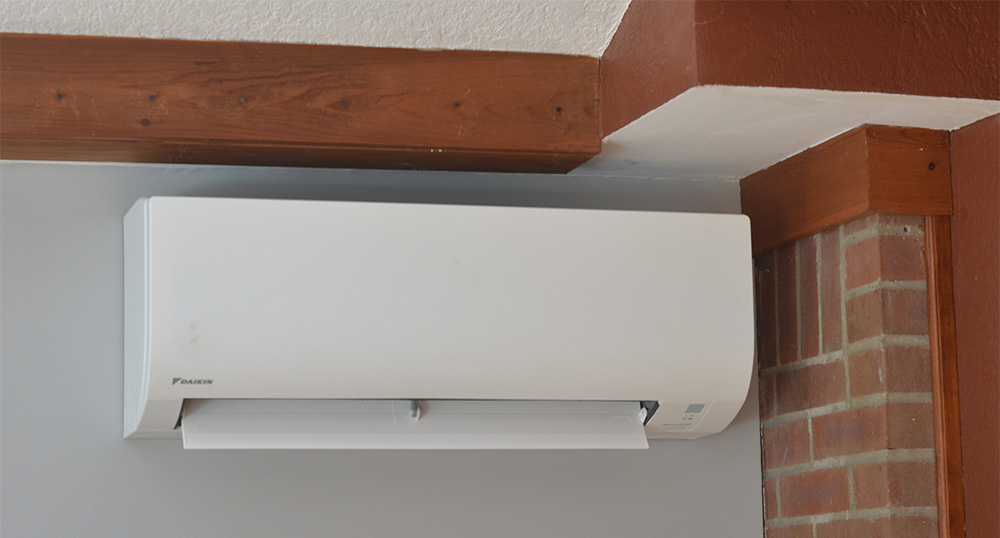
Vanderhorst also mentioned that the heat pump could run differently than traditional heating and cooling systems.
For one thing, the run times can be longer. “It’s hard for consumers not to associate longer run times with higher bills. Sometimes that longer run time equals a smaller bill because it’s doing its continuous work to keep the space at an even temperature,” he explained.
When asked if there were any downsides to heat pumps, Vanderhorst said he did not think there were, other than their complexity. “It is very complex equipment, and it’s important that your service providers understand how to work on them.”
In the past, heat pumps were known to be somewhat noisy. Newer models are quieter.
Ohio residents can use various rebates and tax incentives to help pay for heat pumps. One such opportunity is the Home Electrification and Appliance Rebates program. Federal tax credits are also available for ENERGY STAR Most Efficient air-source heat pumps. There are other money-saving opportunities available. Homeowners should partner with contractors who can assist them.
Climate change is happening. One question that gets asked is, “What can I do about it?” Getting a heat pump might be something to consider.
Nuestras Familias: Taking care of immigrant, migrant, refugee, low-income families

Story by Pam Crabtree | Photos by Lori King
TOLEDO – While the holiday season of giving has past, people of all ages continue to struggle and still need help with securing food, clothes, employment and healthcare. Enter Nuestra Gente (NG), a nonprofit 501(c) 3 organization founded in 2008 by Linda Parra.
Parra, originally from Venezuela, aspired to bring a lifelong passion of community service and to help people when she moved to her new home in Lucas County.
She said NG’s goal is to provide services to needy families in Lucas County and to help them become self-sufficient.
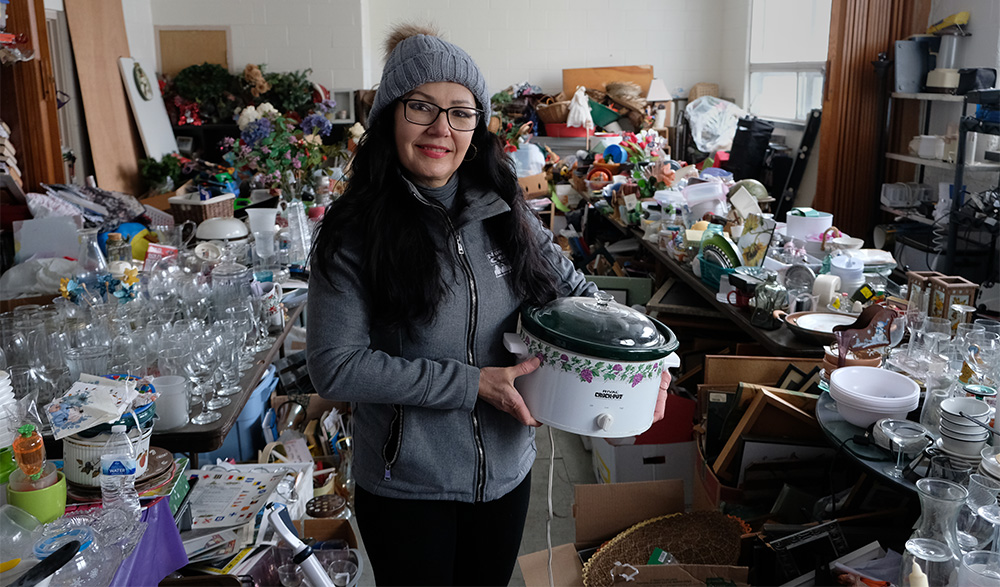
With Parra meeting that heady goal, NG is offering a new program, Nuestras Familias (Spanish for Our Families), launched specifically for immigrant, migrant, refugee and low-income families.
“Our mission is to address the gaps in services for the Latino community in Lucas County,” said Parra.
Given the overwhelming need for help for families, Parra launched Nuestras Familias to assist not only families in Lucas County, but as far away as Columbus. The program helps by providing clothing, furniture, food, childcare and school placement. It also offers medical screenings, translations, interpretations, transportation, legal services and help seeking jobs.
“We have more items than Goodwill,” Parra quipped. “People donate to us because we give to people for free.”
One grateful benefactor of NG’s Nuestras Familias program is Mirna. Mirna, originally from Mexico, and her husband Otto are parents of two children. After reading about Nuestra Gente in a local publication, she contacted Parra for help.
“I’m so happy,” she said when asked about the program. “We needed help with food and clothing, and Nuestras Familias was there for us.”
NG strives to improve the lives of Toledo’s underserved communities, focusing on not only the Hispanic/Latino community, but all Ohioans who seek help.

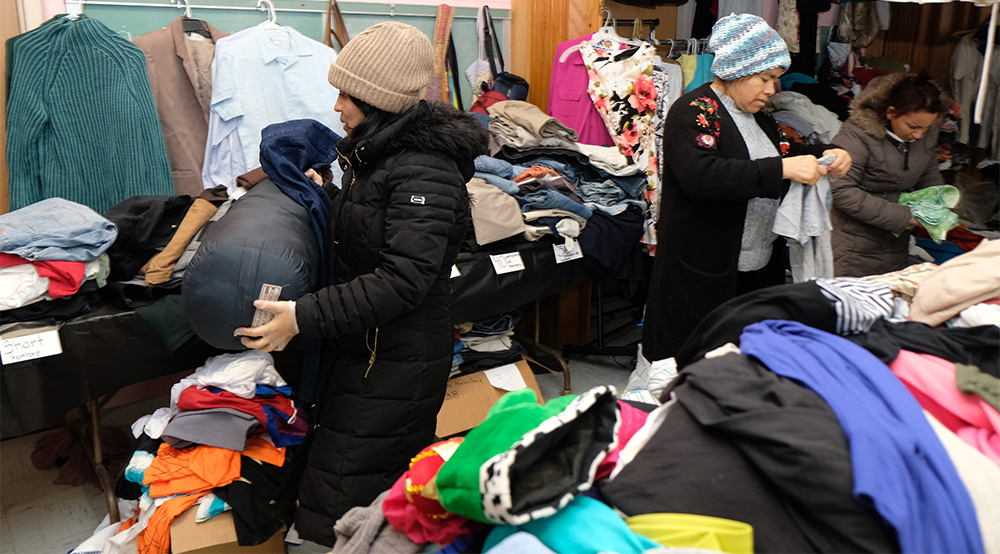
Nuestras Familias is one of the programs and events offered by NG. Others are:
- Holiday Events
- The Art Room
- Health Events
- Fundraisers
- Lupus Awareness
- 419 Food Pantry
Ways to contribute
Monetary donations are tax deductible and always welcome, but there are other ways to contribute, like donating time and energy. One example is the mother-daughter duo, Christina Oyerbides, of Toledo, and her daughter Ester Billups, of Lima, who volunteer their time.
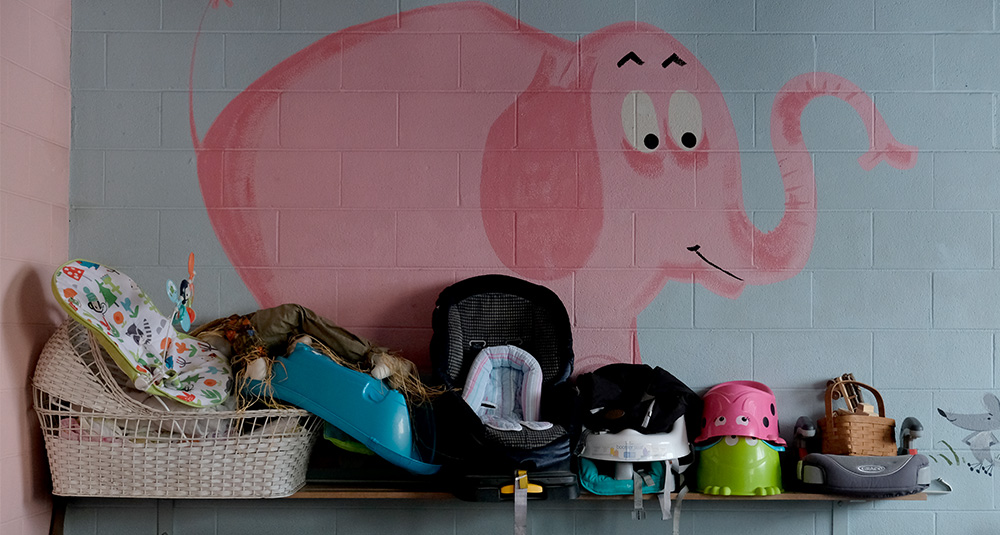
Oyerbides joked that she is “kind of strong, so I go and pick up the donations,” which may consist of furniture, clothing and boxes containing various items. She is also very vocal about spreading the news of the services offered by Nuestra Gente’s Our Families program.
“Whoever hears about it, the doors are open” she said.
Billups enjoys helping families, too. She volunteers on Thanksgiving with packaging and giving supplies out to the community. She also helps organize the items people contribute, such as winter coats, jackets and gloves by size. She said the kids have all their clothes in one room to make it easier for people coming in for assistance.
The Nuestra Gente Community Center is located at 1411 Broadway St. in Toledo.
Email: lindaparra@nuestragentecommunityprojects.org
(See Photo Gallery at bottom of Homepage)
The Flyby Sports Podcast

Lucas and Wood counties are not commonly seen as sports hubs; there are no NFL, NBA, MLB or NHL teams. However, we have two Division 1 universities that are only 30 minutes apart from each other, and that’s pretty rare.
This area loves their Toledo Rockets and BGSU Falcons and will defend each other when it comes to other MAC schools and beyond, but bad blood runs deep … in the best way. The Battle of I-75 holds the title as the best rivalry in the Mid-American Conference (MAC).
Both schools have a large number of local students and know of the rivalry, and through field storming and band bannings, there is no love lost between the two.

When Max Alfonso and I started our spring internship last month, we wanted to put our stamp on the Toledo Free Press and to give ourselves a piece of content we can both be proud of for years to come.
When we first met last month, we went back and forth on BGSU and Toledo athletics. We each put in our two cents on the programs and decided it would make for good audio content. Despite neither of us ever creating our own podcast before, we both were able to learn and adapt to a new way of telling a story.
By creating The Flyby, we believe we found a great way to update Toledo and BGSU fans on moments they missed throughout the week, as well as give them a quick overview of how each program is doing.
Something I think listeners will love about this podcast is the true understanding of each sport we cover, and we cover them all. Max and I both have immersed ourselves into the culture of Toledo and BGSU athletics, and we work well together to explain our own cultures to each other.
This show truly is a love letter to Toledo and BGSU athletics, and we hope to provide a solid and evaluative insight into teams that have a massive amount of community support.
The Flyby is the first podcast produced by the Toledo Free Press and drops every Saturday, so give us a listen!
The second Toledo Free Press podcast, 411 in the 419 with Jaden Jefferson, is currently in development and will debut soon.
Driver’s ed privatization fails teens
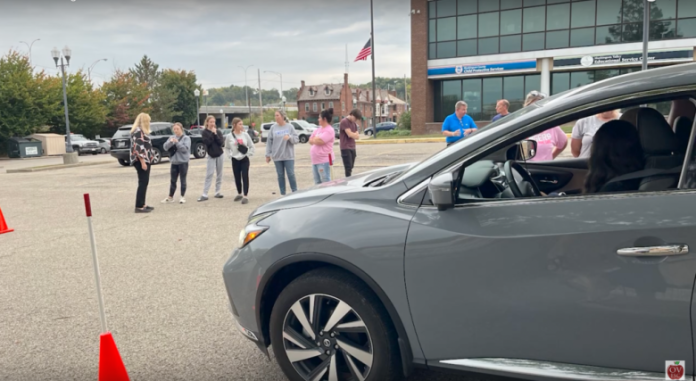
Some young Ohioans are unable to drive legally, limiting their job options and ability to participate in extracurricular activities. But some are pushing to return driver’s ed to schools
This story was originally published by Signal Statewide. Sign up for their free newsletters at SignalOhio.org/StateSignals. Statewide is a media partner of the Toledo Free Press.
By Andrew Tobias | Signal Statehouse

Homer Weekly realized the state had a big problem around 2017, when the private driver’s ed school he ran with his wife in Morgan County started seeing students from places farther and farther outside his small southeastern Ohio community.
“We were getting students from Westerville,” Weekly said, referring to the Columbus suburb 90 miles away. “Parents told us their kids were on waiting lists of over 90 to start driving lessons. That’s when we knew it had become a crisis.”
This type of training used to commonly be provided by high schools. But Weekly, a retired educator, opened his school in 1993, shortly after state lawmakers privatized the industry.
Today, Weekly works for a new, fast-growing school-based driver’s ed program based in Zanesville. It’s on the cutting edge of an effort by Gov. Mike DeWine and others to try to revive public driver’s ed.
In interviews and public comments, state officials and advocates describe a failed privatization effort, particularly for rural and poor urban areas. The result has been a system with limited enrollment slots, high prices and slim profit margins for operators.
In turn, many 16- and 17-year-old Ohioans are unable to drive legally.
This limits their job opportunities and their ability to participate in extracurricular activities. It also places them at a higher risk for crashes if they get their licenses after they turn 18 without driver’s ed, according to a state-funded 2022 study conducted by the Children’s Hospital of Philadelphia and the University of Pennsylvania. Of course, kids do get behind the wheel regardless.
Ohio officials said of the 113 fatal crashes in 2023 that involved teenage drivers, the teen driver lacked a license or permit in 23 percent of those crashes. Ohio officials don’t track exactly how many teens are unable to access driver’s ed. But advocates and people in the industry are aware of the problem.
A different state-funded study completed in 2023 by the same researchers found that teenagers who live in poorer neighborhoods around Columbus were four times less likely to complete driver’s education than others.
“It’s a huge, huge problem, even for families that have the ability to pay for access to it,” said Kristy Amy, chief of programs for Future Plans, a Geauga County-based nonprofit that works to fight poverty in Appalachian Ohio.
How driver’s education works – and doesn’t work – in Ohio
In Ohio, there are two paths to becoming a licensed driver. One applies to 16- and 17-year-olds, who must get 24 hours of classroom instruction — this increasingly is being offered online — and eight hours of in-car training before they can get their license, among other requirements.
The other applies to everyone 18 and up, who must simply pass a driving test and a written exam and undergo a test of their eyesight.
For new drivers under 18, education options can be limited, either because of affordability, or, in the case of rural areas, physical proximity.
Quantifying the problem is difficult. Ten counties in Ohio — Adams, Brown, Harrison, Monroe, Morgan, Noble, Paulding, Pike, Vinton and Wyandot — have no schools offering driver training, according to the state government’s list of licensed providers.
But state officials say their records may not capture the true picture, since the records may just show the providers’ corporate headquarters and not any ancillary facilities, and since schools may offer driver training in a wide area.
Still, advocates and industry officials say there’s clearly a widespread problem in two types of communities – poorer, urban areas where many residents can’t afford driver’s education and in rural areas, where people can’t afford driver’s education and may not have a nearby option.
“Driver’s ed’s expensive,” said Mike Belcoure, manager of driver’s education for AAA Alliance Inc., one of Ohio’s major AAA clubs. “There’s no better way to put it. It is expensive and it prices, unfortunately, some people out of the market.”
AAA Alliance’s in-car driver’s training instruction, based in and around Cincinnati, Columbus and Dayton, costs $650 per student, Belcoure said. Depending on the market, prices can range as low as $400 and as high as $950, he said.
Families face a waitlist for driver’s education classes
Another issue is waitlists. State law requires students to complete driver’s education within six months. So a student who completes classroom training must also be able to quickly find a driver’s training school with availability.
But the waitlists lengthen for providers further away from major cities, he said.
“You go out to the eastern part of the state, it becomes tough. There are, we call them in the industry, driver’s ed deserts where the supply’s just so low, it is hard for students to find,” Belcoure said.
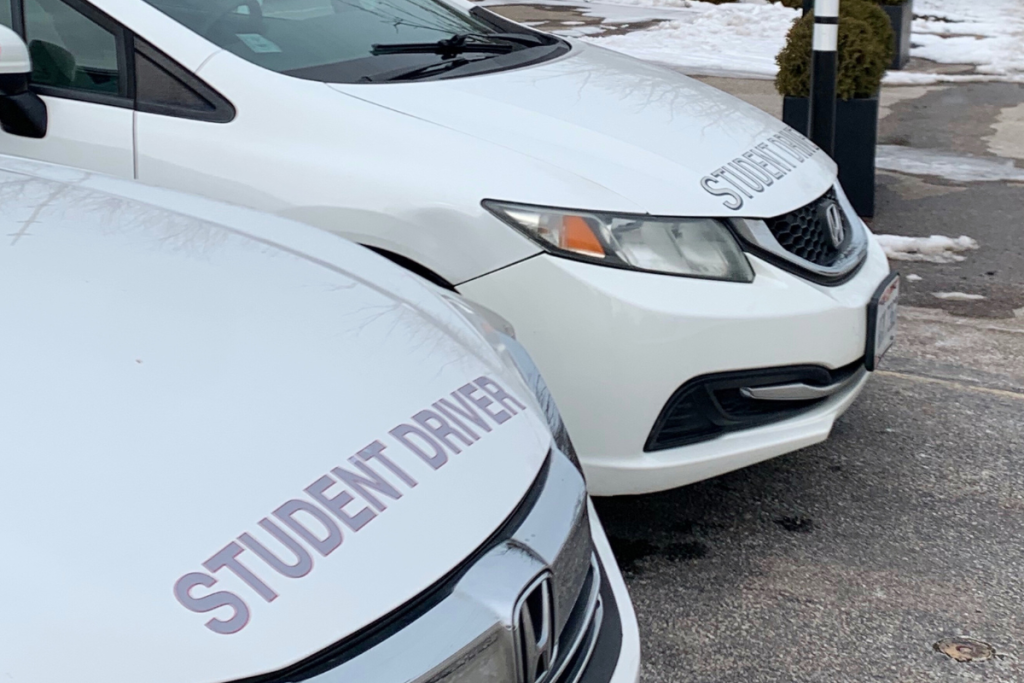
AAA is a nonprofit, member-owned cooperative, and driver’s education is part of its mission. But for mom-and-pop, for-profit operators trying to get started, starting and running a driver’s training school is a difficult proposition.
Major costs for driving schools include buying and insuring vehicles, and hiring instructors who are willing to get in the car with inexperienced teenage drivers. Some schools were forced to close during the coronavirus pandemic and haven’t reopened.
This explains why private schools are more likely to be available in big cities, where they can count on higher volumes of students.
“Driver training is a difficult business model,” said Kimberly Schwind, assistant director of the Ohio Traffic Safety Office, part of the Department of Public Safety. “Instructors don’t get paid a lot. So it’s difficult to find instructors. You need instructors to find kids. If you pay instructors more, you have to raise prices more. And it’s already too high for most families. It’s a difficult situation.”
One major rural driver’s education business, Capabilities Inc., is able to meet its bottom line in part by doing work for the government. The company, which is based in Saint Marys with satellite locations around the western, central and southern part of the state, does a significant amount of business by offering training to developmentally disabled adults, which makes it eligible for local and state funding.
Owners Bill and Karen Blumhorst say their company also offers traditional under-18 driver’s training for $450 in Saint Marys because they’re committed to their community.
But, in the roughly 25 years their company has been in business, “There definitely are times we’ve discussed, is it financially prudent to keep on providing the service?” Karen Blumhorst said.
DeWine calls for expanded driver’s ed requirements
Despite the existing system’s limitations, DeWine late last year announced he’d like to change state law to require all new drivers, and not just 16- and 17-year olds, to go through driver’s ed before getting their license.
The proposal got some wider news coverage due to issues faced in Springfield, where a mass influx of Haitian migrants has introduced a large number of drivers who are unfamiliar with U.S. driving laws.
DeWine has taken other steps in the past couple of years to address driver’s education availability, such as creating a scholarship program targeted at rural and urban areas. State officials say their Drive to Succeed scholarship program spent $3 million paying to put 5,500 students – or about $550 per student – through driver’s education.
At a Springfield City Commission meeting in October, DeWine’s public safety director, Andy Wilson, said the governor and Ohio First Lady Fran DeWine met with insurance industry executives in the summer of 2024 to discuss the plan to boost driver’s education requirements.
After commission officials raised concerns about the price of driver’s ed, Wilson acknowledged the lack of existing access. He said it traces back to state officials’ decision to move driver’s ed out of public schools in the early 1990s.
“The state privatized it. And when they did they radically altered the model, they radically altered accessibility, and they radically altered capacity. So yes, there is a problem.”
In recent comments to reporters, DeWine said he’ll be talking to lawmakers about ways to expand driver’s ed access soon, possibly via the state budget bill he’s planning to release next week.
“This is something I think that is very needed. There’s a lot of, I think, support for that out there. So we’ll be talking more to the legislature about that in the months to come,” DeWine said.
A possible blueprint to expand driver’s ed opportunities
The new driver’s education program that Homer Weekly runs in Zanesville could offer a blueprint for how the state will approach this issue.
Weekly works for a public school-based driver’s education program called the Muskingum Ohio Valley Educational Service Center Driving School that’s supported by two different education service centers, government agencies that provide support services to local districts.
Local education service officials launched the program in October 2022 using federal coronavirus relief money. The program has expanded thanks to a $1 million state grant in January 2024, awarded by the DeWine administration as part of the state effort to expand driver’s training options.
Weekly and his colleagues run what amounts to a franchise model for driver’s ed. Four core employees administer the program from offices in Zanesville and Cambridge, handling money, developing curriculum and hiring, training and evaluating drivers, among other responsibilities.
Students pay $350 — the very low end of the market price range. And participating school districts provide state-approved driver’s education, including in-car instruction.
Its handful of employees include Weekly, who is a former assistant principal and school athletic director, and Richard Hall, a former superintendent at the Mid-East Career and Technology Centers in Zanesville.
Program leaders say in-school driver’s education solves some of the major problems private providers face.
First, direct government subsidies allow them to charge lower prices. Schools also can roll a major driver’s ed expense — vehicle insurance — into their existing fleet insurance for their school buses.
Schools also help provide a pool of motivated driving instructors, in the form of teachers, bus drivers, cooks and other school employees. Two-thirds of the program’s instructors are school employees, officials said.
They also provide a centralized point to pick up kids and are able to more easily work around the students’ academic schedules.
The biggest burden the driving program poses, program officials say, is the cost of buying cars.
“We have schools in this area that do not offer driver’s ed through us. They stay out of the driver’s ed business, and I think they don’t understand how easy it is for them,” Hall said.
The state grant has allowed the program to grow rapidly. It began with 13 school districts, but today covers 30 districts in 18 counties ranging from Oxford near Cincinnati to the Toledo area.
“I think, you know, it’s just going to catch fire, just like anything else, that it’ll be in almost every school in a couple years,” said Eastin Lewllyn, an official with the Muskingum Valley Educational Service Center that helps runs the program.
The growth has happened with no real advertising, program officials said, and little news coverage.
Program officials say that some private providers aren’t thrilled with their expansion, viewing it as the government competing with and threatening their livelihood.
Private driver’s ed providers recently organized a trade group called the Ohio Driving School Association. The group didn’t return messages.
But officials at the Muskingum Ohio Valley Educational Service Center Driving School believe in their model, saying it prioritizes education, not profit.
“We’re fortunate by our model and being educationally based. If a kid needs something, we don’t need to charge you for it. We have enough resources to do that,” Hall said. “A small school doesn’t have that.”
Signal Statewide is a nonprofit news organization covering government, education, health, economy and public safety.

